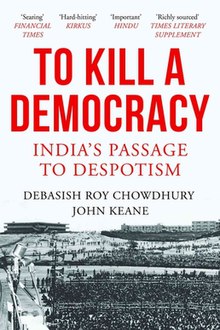Review By Dr. Goraksha Dere, Asst. Professor, Baburaoji Gholap College, Sangvi, Pune Combining poignant life stories with sharp scholarly insight, it rejects the belief that India was once a beacon of democracy but is now being ruined by the destructive
Read More
Review By Dr. Goraksha Dere, Asst. Professor, Baburaoji Gholap College, Sangvi, Pune
Combining poignant life stories with sharp scholarly insight, it rejects the belief that India was once a beacon of democracy but is now being ruined by the destructive forces of Modi-style populism. The book details the deeper historical roots of the present-day assaults on civil liberties and democratic institutions. Democracy, the authors also argue, is much more than elections and the separation of powers. It is a whole way of life lived in dignity, so they pay special attention to the decaying social foundations of Indian democracy. Compellingly, the book describes daily struggles for survival and explains how lived social injustices and unfreedoms rob Indian elections of their meaning, while at the same time feeding the decadence and iron-fisted rule of its governing institutions. Much more than a book about India, To Kill A Democracy argues that what is happening in the country is globally important, and not just because every third person living in a democracy is an Indian. It shows that when democracies rack and ruin their social foundations, they don’t just kill off the spirit and substance of democracy. They lay the foundations for despotism.
A combination of investigative reporting and political theory, this probing book argues that “social death” is the reason for the decline of democracy, with India offered as a case study. The authors detail India’s broken health-care system, chronic hunger, land grabs, air and water pollution, dysfunctional public transport networks, religious bigotry, pervasive illiteracy, debt bondage, child slavery, and mistreatment of women. As people come to accept deep social and economic inequality, the system erodes the dignity of its citizens the principle on which democracy depends. That social breakdown produces hordes of cynical young people ready to join authoritarian militias and political movements, dynastic parties run by corrupt politicians, captive media, dysfunctional legislatures, subservient security agencies, and partisan courts. Elections, marred by violence and money politics, become exercises in “voluntary servitude.” Chowdhury and Keane say these problems started long before Narendra Modi became prime minister in 2014 and have grown worse under his leadership. One wonders, however, whether to blame social ills for democratic decline or the reverse.
A) The book takes you through many instances of democracy failures with ruinous social consequences. From the vast hinterland to the glittering façade of urban ecosystem, it is the plunder by colluding oligarchs that has scripted a sordid story of the demise of democracy, be it the ownership of land, choice of crops or access to water. The India Story, the one told by champions of democracy citing Western validation of our democracy, its institutional evolution and surviving Emergency, today is in disarray. B) Institutions expected to hold the democratic super-structure opposition, judiciary, media, civil society have all caved in before the executive juggernaut. The most worrisome is judiciary’s capitulation. The apex court, which is supposed to be a great bulwark standing for liberties and rights of the people, has abdicated its responsibility over issues of constitutional importance like the Kashmir issue, electoral bonds, habeas corpus petitions and the Citizenship Amendment Act.
C) The efforts of elected governments to stymie institutions have been there since independence. What has happened in the present regime is that they have been legitimised. Anxieties about India’s current democratic decline are stoked by the open violations of conventions by the present dispensation riding on popular support and a monochromatic Hindu nationalism. D) The book makes a disturbing read. There are recurring themes of inequality, injustice, an unequal application of law and prejudice. It delves into the dark heart that beats below the idealism of democracy just like Harper Lee explored the one below the quiet surface of Maycomb in her celebrated work whose title is alluded to in that of the book. E) So, is Indian democracy nearing its end? The authors sign off with a ray of hope lest you should resign to such a fate. They see a lining in India’s inherent plurality of languages, ethnicities, caste and class divisions; in the empowerment of its womenfolk evident through intolerance towards domestic violence, rise in school enrollment of girls, participation in business and economical life; and in the vibrant legacy of non-violent mass mobilization as shown by anti-CAA and farmers’ protests. One of the enduring strengths of democracy is whenever it gets sick a search for cure is a natural corollary. The cure requires a diagnosis. The book provides one.
Show Less

